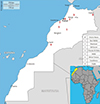1. Knobel DL, Cleaveland S, Coleman PG, et al. Re-evaluating the burden of rabies in Africa and Asia. Bull World Health Organ. 2005; 83:360–368.
2. Matter H, Blancou J, Benelmouffok A, Hammami S, Fassi-Fehri N. Rabies in North Africa and Malta. In : King AA, Fooks AR, Aubert M, Wandeler AI, editors. Historical perspective of rabies in Europe and the Mediterranean Basin. Paris: World Organisation for Animal Health;2004. p. 185–199.
3. Fassi-Fihri O. Historique et situation épidémiologique de la rage au Maroc. Renforcement de la surveillance et des systèmes d'alerte pour la fièvre catarrhale ovine, la fièvre du Nil occidental et la rage au Maroc, en Algérie et en Tunisie. Projet FAO GCP/RAB/002/FRA. Rome: Food and Agriculture Organization of the United Nations;2008.
4. Dodet B. Africa Rabies Bureau (AfroREB). The fight against rabies in Africa: from recognition to action. Vaccine. 2009; 27:5027–5032.

5. El-Harrak M. Epidemiological factors and control of rabies in North Africa. In : Compendium of the OIE Global Conference on Rabies Control; 2011 Sep 7-9; Incheon, Korea. Paris: World Organisation for Animal Health;2012. p. 45–49.
8. Darkaoui S, Boue F, Demerson JM, Fassi Fihri O, Yahia KI, Cliquet F. First trials of oral vaccination with rabies SAG2 dog baits in Morocco. Clin Exp Vaccine Res. 2014; 3:220–226.

9. Meslin FX. Strategy, approaches, guidance and resources for human and dog rabies control. In : FAO/GARC Workshop; 2012 Nov 6-8; Rome, Italy. Rome: Food and Agriculture Organization of the United Nations;2013. p. 3–5.
10. World Health Organization. Oral vaccination of dogs against rabies: guidance for research on oral rabies vaccines and field application of oral vaccination of dogs against rabies. Geneva: World Health Organization;2007.
11. World Health Organization. WHO expert consultation on rabies: second report. Geneva: World Health Organization;2013.
12. Aubert MF. Practical significance of rabies antibodies in cats and dogs. Rev Sci Tech. 1992; 11:735–760.

13. Barth R, Gruschkau H, Jaeger O. Chick-embryo-cell inactivated rabies vaccine for veterinary use: laboratory and field experience. In : Kuwert E, Mérieux C, Koprowski H, Bogel K, editors. Rabies in the tropics. Berlin: Springer Verlag;1985. p. 241–248.
14. Cliquet F, Aubert M, Sagne L. Development of a fluorescent antibody virus neutralisation test (FAVN test) for the quantitation of rabies-neutralising antibody. J Immunol Methods. 1998; 212:79–87.

16. European Depatment for the Quality of Medicines, Council of Europe. Rabies vaccine (inactivated) for veterinary use. Mongraph 0451. European Pharmacopoeia. 7th ed. Strasbourg: Council of Europe;2013. p. 1008–1011.
17. Perrin P, Jacob Y, Aguilar-Setien A, et al. Immunization of dogs with a DNA vaccine induces protection against rabies virus. Vaccine. 1999; 18:479–486.

18. Meslin FX, Kaplan MM, Koprowski H. Laboratory techniques in rabies. 4th ed. Geneva: World Health Organization;1996.
19. Cliquet F, Sagne L, Schereffer JL, Aubert MF. ELISA test for rabies antibody titration in orally vaccinated foxes sampled in the fields. Vaccine. 2000; 18:3272–3279.

20. Millan J, Chirife AD, Kalema-Zikusoka G, et al. Serosurvey of dogs for human, livestock, and wildlife pathogens, Uganda. Emerg Infect Dis. 2013; 19:680–682.

21. Wasniewski M, Guiot AL, Schereffer JL, Tribout L, Mahar K, Cliquet F. Evaluation of an ELISA to detect rabies antibodies in orally vaccinated foxes and raccoon dogs sampled in the field. J Virol Methods. 2013; 187:264–270.

22. Hammami S, Schumacher C, Cliquet F, Tlatli A, Aubert A, Aubert M. Vaccination of Tunisian dogs with the lyophilised SAG2 oral rabies vaccine incorporated into the DBL2 dog bait. Vet Res. 1999; 30:607–613.
23. Coleman PG, Dye C. Immunization coverage required to prevent outbreaks of dog rabies. Vaccine. 1996; 14:185–186.

24. Kallel H, Diouani MF, Loukil H, et al. Immunogenicity and efficacy of an in-house developed cell-culture derived veterinarian rabies vaccine. Vaccine. 2006; 24:4856–4862.

25. Mansfield KL, Burr PD, Snodgrass DR, Sayers R, Fooks AR. Factors affecting the serological response of dogs and cats to rabies vaccination. Vet Rec. 2004; 154:423–426.

26. Minke JM, Bouvet J, Cliquet F, et al. Comparison of antibody responses after vaccination with two inactivated rabies vaccines. Vet Microbiol. 2009; 133:283–286.

27. Cliquet F, Muller T, Mutinelli F, et al. Standardisation and establishment of a rabies ELISA test in European laboratories for assessing the efficacy of oral fox vaccination campaigns. Vaccine. 2003; 21:2986–2993.

28. Cliquet F, Verdier Y, Sagne L, et al. Neutralising antibody titration in 25,000 sera of dogs and cats vaccinated against rabies in France, in the framework of the new regulations that offer an alternative to quarantine. Rev Sci Tech. 2003; 22:857–866.

29. Tepsumethanon W, Polsuwan C, Lumlertdaecha B, et al. Immune response to rabies vaccine in Thai dogs: a preliminary report. Vaccine. 1991; 9:627–630.

30. Perrin P, Jacob Y, Desmezieres E, Tordo N. DNA-based immunisation against rabies and rabies-related viruses: towards multivalent vaccines. Dev Biol (Basel). 2000; 104:151–157.
31. Cliquet F, Barrat J, Guiot AL, et al. Efficacy and bait acceptance of vaccinia vectored rabies glycoprotein vaccine in captive foxes (Vulpes vulpes), raccoon dogs (Nyctereutes procyonoides) and dogs (Canis familiaris). Vaccine. 2008; 26:4627–4638.

32. Davlin SL, Vonville HM. Canine rabies vaccination and domestic dog population characteristics in the developing world: a systematic review. Vaccine. 2012; 30:3492–3502.

33. Lembo T, Hampson K, Kaare MT, et al. The feasibility of canine rabies elimination in Africa: dispelling doubts with data. PLoS Negl Trop Dis. 2010; 4:e626.










 PDF
PDF ePub
ePub Citation
Citation Print
Print



 XML Download
XML Download